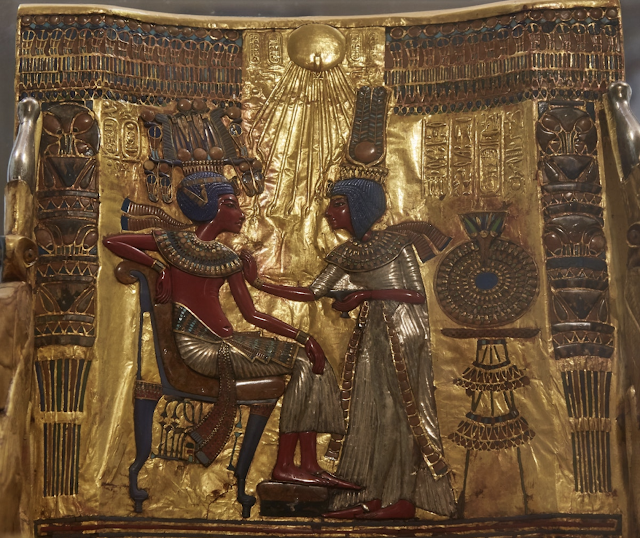Egyptian Museum at Cairo had many surprises. One of them was the Tutankhamen Section. Tutankhamun’s tomb like all that of other contemporary pharaohs was in the Valley of Kings in Luxor, erstwhile Thebes. While the tombs of all other Pharaohs were robbed, Tut’s tomb was buried under a landslide soon after sealing and its location was lost. It was discovered intact with all its artifacts in 1922 ( ~3200 year after his burial) by a team led by British Egyptologist Carter. The sheer magnificence of the artifacts in the tomb of a Pharaoh of minor significance (he died at ~19 of age), is amazing and leaves one wondering about artifacts in tombs like that of Ramses III or Amenhotep who were conquerors and bought riches to Egypt.
Tut’s mummy was placed in multiple coffins, fitting inside each other like Russian dolls. And the whole arrangement was inside four shrines, one inside the other. The mummy had famous solid gold mask. The intricate decoration on each coffin left one gasping. Tut’s jewelry could make anyone jealous. His dagger supposedly made from extra-terrestrial origin iron left us intrigued; we can imagine that the iron came from a meteorite but how was the dagger forged? The technology to melt iron did not exist at that time.
No photography was allowed inside Tut’s section, but the outermost shrine, all gilded with gold obviously, stood outside the section (photo attached). One of the most beautiful artifact was the gold leaf throne made in Amarna Style described later.
Egyptian statues and paintings are in a rigid pose, whether seated on standing. The standing statues are striding forward (“for life” as the guides love to say) or in Osiris pose with arms folded on the chest and legs together ( if made after death). The statues have elaborate headgear and dresses, all carved with meticulous detail out of some of the hardest stones. It also has a falcon at the back (for protection). The name of the Pharoah is carved in a Cartouche in the accompanying text on the statue itself. This is really helpful since all statues have nearly the same features. Except those from Amarna period. The statues as well as the painting of this period are very different from the art work before and after this period.
Amarna period, a very short one, is within the reign of Pharoah Akhenaten, the father (or grandfather?) of Tut. He upturned a lot of established practices including the polytheistic nature of Egyptian pagan religion. He decided to worship only “the disc of Sun god” called Aten. He even named Tut as Tutenkaten, removed the rights of all the priests and changed the rigid art style to a more natural one and moved the capital from the Thebes (present day Luxor) to present day Tel Amarna. In Ancient Egyptian culture the king was given the divine right to rule, which was given to him through the priests. In this equation the priest had a lot of clout and all the kings ensured that the priests were happy. Maybe the reason for this drastic action was that the priests became too powerful and Akhenaten decided to clip their wings.
After the “heretic king” Akhenaten died, his city, his temples, his palaces, even his tomb were destroyed and his name was removed from all monuments. Egyptians believe that if there is somebody to take the name of a person the person still lives on in the after world. I know this sound very Harry Potter like, but such was their belief. The boy king Tut succeeded Akhenaten at 9 years of age and he ( or his regent) restored the earlier religious practices. When Tut died at a rather young age, a number of Amarna art pieces were buried in Tut’s tomb, making his tomb much richer than probably deserved. Looks like nobody wanted to have anything to do with Amarna art pieces and were happy to bury them all in Tut’s tomb. Since Tut’s tomb remained hidden, the Amarna art work survived. Akhenaten had the last laugh. :)
In Amarna art, unlike the traditional egyptian style, the Pharaoh is shown having a voluptuous body with nearly feminine features unlike the formal rigid pose in the normal egyptian style. A few Amarna statues can be seen in the museum in a special Amarna section. Here Akhenaten is seen in Osiris pose. Notice the facial features and the big belly.
For more details on Amarna, a very nice description can be found at https://sailingstonetravel.com/hunting-for-amarna-art-across-egypt/
One of the most famous painting of Amarna period portrays the Pharoah Akhenatan in a languid intimate pose with queen Nefertiti along with his daughters playing around them. Tuts throne has a similar painting/mural with king and queen in the foreground and Aten blessing the king and the queen. At the end of each " sun ray" is a hand blessing/protecting the royal couple. Since the throne was in the Tut section I could not photograph it, but I found a good photograph ( above) online (link above).
Subscribe by Email
Follow Updates Articles from This Blog via Email






No Comments